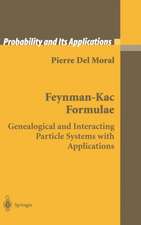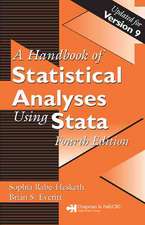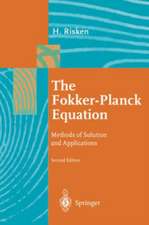An Introduction to the Theory of Point Processes: Volume II: General Theory and Structure: Probability and Its Applications
Autor D.J. Daley, David Vere-Jonesen Limba Engleză Paperback – 31 oct 2014
Volume I contains the introductory chapters from the first edition together with an account of basic models, second order theory, and an informal account of prediction, with the aim of making the material accessible to readers primarily interested in models and applications. It also has three appendices that review the mathematical background needed mainly in Volume II.
Volume II sets out the basic theory of random measures and point processes in a unified setting and continues with the more theoretical topics of the first edition: limit theorems, ergodic theory, Palm theory, and evolutionary behaviour via martingales and conditional intensity. The very substantial new material in this second volume includes expanded discussions of marked point processes, convergence to equilibrium, and the structure of spatial point processes.
| Toate formatele și edițiile | Preț | Express |
|---|---|---|
| Paperback (1) | 958.38 lei 6-8 săpt. | |
| Springer – 31 oct 2014 | 958.38 lei 6-8 săpt. | |
| Hardback (1) | 1399.43 lei 6-8 săpt. | |
| Springer – 12 noi 2007 | 1399.43 lei 6-8 săpt. |
Din seria Probability and Its Applications
-
 Preț: 392.60 lei
Preț: 392.60 lei -
 Preț: 395.09 lei
Preț: 395.09 lei - 18%
 Preț: 739.00 lei
Preț: 739.00 lei - 18%
 Preț: 783.35 lei
Preț: 783.35 lei - 15%
 Preț: 640.24 lei
Preț: 640.24 lei - 18%
 Preț: 948.47 lei
Preț: 948.47 lei -
 Preț: 391.99 lei
Preț: 391.99 lei - 18%
 Preț: 1399.43 lei
Preț: 1399.43 lei - 15%
 Preț: 471.21 lei
Preț: 471.21 lei - 20%
 Preț: 569.10 lei
Preț: 569.10 lei - 15%
 Preț: 691.08 lei
Preț: 691.08 lei -
 Preț: 385.08 lei
Preț: 385.08 lei - 18%
 Preț: 1123.19 lei
Preț: 1123.19 lei -
 Preț: 393.52 lei
Preț: 393.52 lei - 15%
 Preț: 646.62 lei
Preț: 646.62 lei -
 Preț: 461.65 lei
Preț: 461.65 lei - 18%
 Preț: 787.91 lei
Preț: 787.91 lei - 15%
 Preț: 702.41 lei
Preț: 702.41 lei - 15%
 Preț: 557.27 lei
Preț: 557.27 lei -
 Preț: 382.36 lei
Preț: 382.36 lei - 18%
 Preț: 1120.99 lei
Preț: 1120.99 lei - 18%
 Preț: 786.49 lei
Preț: 786.49 lei - 15%
 Preț: 655.78 lei
Preț: 655.78 lei - 18%
 Preț: 785.68 lei
Preț: 785.68 lei -
 Preț: 385.25 lei
Preț: 385.25 lei - 15%
 Preț: 701.90 lei
Preț: 701.90 lei - 18%
 Preț: 915.79 lei
Preț: 915.79 lei - 18%
 Preț: 1345.87 lei
Preț: 1345.87 lei - 18%
 Preț: 733.65 lei
Preț: 733.65 lei -
 Preț: 384.31 lei
Preț: 384.31 lei - 15%
 Preț: 582.80 lei
Preț: 582.80 lei -
 Preț: 361.42 lei
Preț: 361.42 lei - 15%
 Preț: 709.09 lei
Preț: 709.09 lei - 15%
 Preț: 644.95 lei
Preț: 644.95 lei - 15%
 Preț: 648.24 lei
Preț: 648.24 lei - 18%
 Preț: 897.02 lei
Preț: 897.02 lei - 15%
 Preț: 528.13 lei
Preț: 528.13 lei - 15%
 Preț: 727.59 lei
Preț: 727.59 lei - 15%
 Preț: 470.88 lei
Preț: 470.88 lei - 18%
 Preț: 1001.81 lei
Preț: 1001.81 lei - 18%
 Preț: 954.14 lei
Preț: 954.14 lei -
 Preț: 392.60 lei
Preț: 392.60 lei - 15%
 Preț: 652.31 lei
Preț: 652.31 lei - 18%
 Preț: 1396.43 lei
Preț: 1396.43 lei - 18%
 Preț: 966.15 lei
Preț: 966.15 lei - 18%
 Preț: 1335.93 lei
Preț: 1335.93 lei
Preț: 958.38 lei
Preț vechi: 1168.76 lei
-18% Nou
Puncte Express: 1438
Preț estimativ în valută:
183.39€ • 196.10$ • 152.90£
183.39€ • 196.10$ • 152.90£
Carte tipărită la comandă
Livrare economică 18 aprilie-02 mai
Preluare comenzi: 021 569.72.76
Specificații
ISBN-13: 9781489985385
ISBN-10: 1489985387
Pagini: 592
Ilustrații: XVII, 573 p.
Dimensiuni: 155 x 235 x 31 mm
Greutate: 0.82 kg
Ediția:2nd ed. 2008
Editura: Springer
Colecția Springer
Seria Probability and Its Applications
Locul publicării:New York, NY, United States
ISBN-10: 1489985387
Pagini: 592
Ilustrații: XVII, 573 p.
Dimensiuni: 155 x 235 x 31 mm
Greutate: 0.82 kg
Ediția:2nd ed. 2008
Editura: Springer
Colecția Springer
Seria Probability and Its Applications
Locul publicării:New York, NY, United States
Public țintă
ResearchCuprins
Basic Theory of Random Measures and Point Processes.- Special Classes of Processes.- Convergence Concepts and Limit Theorems.- Stationary Point Processes and Random Measures.- Palm Theory.- Evolutionary Processes and Predictability.- Spatial Point Processes.
Recenzii
From the reviews of the second edition:
"This book is the second Volume of the original single Volume from 1988, the first volume having appeared in 2003.… It contains several topics that have been studied since 1988, a list of references that is greatly enlarged and improved.… In all, the second volume…serves as an excellent and unique standard reference to the theory of point processes and may not be missed by anyone dealing in a serious way with point processes." (A. Stein, Kwantitatieve Methoden, Issue R12, 2008)
"Although the first and second volumes are not physically bound, they are clearly intimately linked.… A welcome new chapter in this second edition provides a brief introduction to spatial point processes surveying both descriptive methods for point patterns and point process models.… Challenging exercises at the end of each chapter both illuminate and expand on the text. The writing flows, yet is always meticulous, all notation is well defined , and a clear love for the subject is transparent throughout. The two volumes together are a major achievement by the authors and deserve to become a main reference in the area of point processes." (Michael Sherman, Journal of the American Statistical Association, March 2009, Vol. 104, No. 485)
"The second volume focuses on the structure and general theory of point processes … . each topic is carefully motivated and an extensive literature review is provided. … Volume II will be of particular use to the specialist with a good background in probability, measure theory, and topology. … belong on the shelf of any modern probability theorist." (Gail Ivanoff, Mathematical Reviews, Issue 2009 b)
"This book is the second Volume of the original single Volume from 1988, the first volume having appeared in 2003.… It contains several topics that have been studied since 1988, a list of references that is greatly enlarged and improved.… In all, the second volume…serves as an excellent and unique standard reference to the theory of point processes and may not be missed by anyone dealing in a serious way with point processes." (A. Stein, Kwantitatieve Methoden, Issue R12, 2008)
"Although the first and second volumes are not physically bound, they are clearly intimately linked.… A welcome new chapter in this second edition provides a brief introduction to spatial point processes surveying both descriptive methods for point patterns and point process models.… Challenging exercises at the end of each chapter both illuminate and expand on the text. The writing flows, yet is always meticulous, all notation is well defined , and a clear love for the subject is transparent throughout. The two volumes together are a major achievement by the authors and deserve to become a main reference in the area of point processes." (Michael Sherman, Journal of the American Statistical Association, March 2009, Vol. 104, No. 485)
"The second volume focuses on the structure and general theory of point processes … . each topic is carefully motivated and an extensive literature review is provided. … Volume II will be of particular use to the specialist with a good background in probability, measure theory, and topology. … belong on the shelf of any modern probability theorist." (Gail Ivanoff, Mathematical Reviews, Issue 2009 b)
Textul de pe ultima copertă
Point processes and random measures find wide applicability in telecommunications, earthquakes, image analysis, spatial point patterns and stereology, to name but a few areas. The authors have made a major reshaping of their work in their first edition of 1988 and now present An Introduction to the Theory of Point Processes in two volumes with subtitles Volume I: Elementary Theory and Methods and Volume II: General Theory and Structure.
Volume I contains the introductory chapters from the first edition together with an account of basic models, second order theory, and an informal account of prediction, with the aim of making the material accessible to readers primarily interested in models and applications. It also has three appendices that review the mathematical background needed mainly in Volume II.
Volume II sets out the basic theory of random measures and point processes in a unified setting and continues with the more theoretical topics of the first edition: limit theorems, ergodic theory, Palm theory, and evolutionary behaviour via martingales and conditional intensity. The very substantial new material in this second volume includes expanded discussions of marked point processes, convergence to equilibrium, and the structure of spatial point processes.
D.J. Daley is recently retired from the Centre for Mathematics and Applications at the Australian National University, with research publications in a diverse range of applied probability models and their analysis; he is coauthor with Joe Gani of an introductory text on epidemic modelling. The Statistical Society of Australia awarded him their Pitman Medal for 2006.
D. Vere-Jones is an Emeritus Professor at Victoria University of Wellington, widely known for his contributions to Markov chains, point processes, applications in seismology, and statistical education. He is a fellow and Gold Medallist of the Royal Society of New Zealand, and a director of the consulting group Statistical Research Associates.
Volume I contains the introductory chapters from the first edition together with an account of basic models, second order theory, and an informal account of prediction, with the aim of making the material accessible to readers primarily interested in models and applications. It also has three appendices that review the mathematical background needed mainly in Volume II.
Volume II sets out the basic theory of random measures and point processes in a unified setting and continues with the more theoretical topics of the first edition: limit theorems, ergodic theory, Palm theory, and evolutionary behaviour via martingales and conditional intensity. The very substantial new material in this second volume includes expanded discussions of marked point processes, convergence to equilibrium, and the structure of spatial point processes.
D.J. Daley is recently retired from the Centre for Mathematics and Applications at the Australian National University, with research publications in a diverse range of applied probability models and their analysis; he is coauthor with Joe Gani of an introductory text on epidemic modelling. The Statistical Society of Australia awarded him their Pitman Medal for 2006.
D. Vere-Jones is an Emeritus Professor at Victoria University of Wellington, widely known for his contributions to Markov chains, point processes, applications in seismology, and statistical education. He is a fellow and Gold Medallist of the Royal Society of New Zealand, and a director of the consulting group Statistical Research Associates.
Caracteristici
Point processes and random measures are widely applied in telecommunications, earthquakes, image analysis, spatial point patterns, and stereology Volume One incorporates introductory material from the First Edition with a foretaste of more advanced concepts Volume Two builds on general theory with additional material on marked and spatial processes Abundant examples both reinforce core understanding and illustrate further applications of the models






















